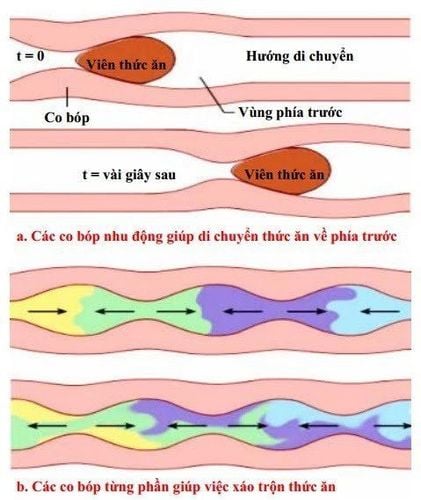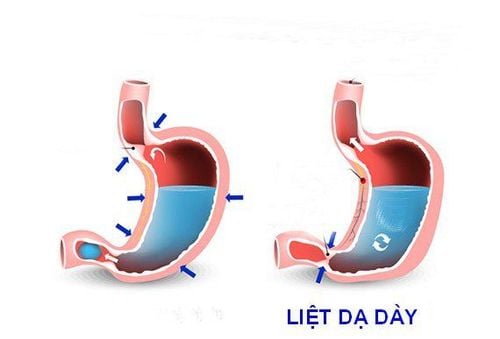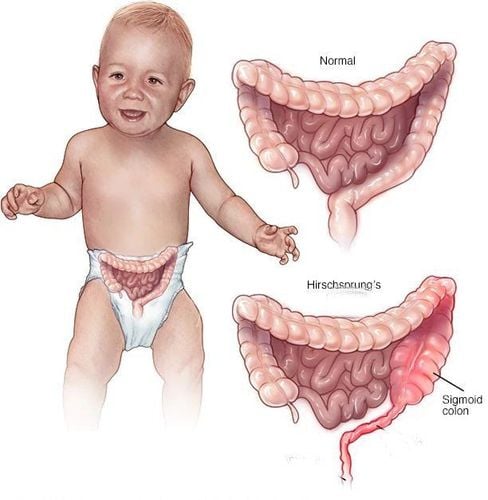This is an automatically translated article.
In the digestive system, food is moved through the digestive tract thanks to the rhythmic contraction of the digestive tract, which helps the food move through the intestinal lumen and is called "digestive peristalsis". When having digestive motility disorders, these contractions do not work properly and increase the risk of gastrointestinal diseases for the patient. So what causes gastrointestinal motility disorders?
1. Digestive tract and gastrointestinal motility
1.1 What is the alimentary canal? The human digestive system consists of the alimentary canal and digestive accessory organs (tongue, salivary glands, pancreas, liver, and gallbladder). In this system, the digestive process has many stages, food is first introduced into the oral cavity. Here, digestion involves the breakdown of food into smaller components that can be absorbed and assimilated by the body. In the oral cavity, saliva helps swallow food to pass through the esophagus and into the stomach.
Digestion then continues, breaking down the large molecules of food into smaller molecules. Nutrients are absorbed through the lining of the digestive tract, this process mainly taking place in the small intestine into the bloodstream. However, digestion occurs in all parts of the gastrointestinal tract, extending from the mouth to the anus.
1.2. What is digestive motility? Parts of the digestive tract have specialized functions, but are all made of the same basic tissue layers. The wall of the tube from the inside to the outside: mucosa, submucosa, muscle layer and serosa. It is because of the basic similarities in anatomical structure, especially the appearance of the muscular layer that creates the peristalsis of the digestive tract.
Peristalsis is a wavy contraction that travels along the digestive tract. Under normal conditions, this layer of muscle contracts and relaxes in a coordinated, rhythmic fashion that pushes food from the esophagus to the stomach and through the intestines to the anus.
In the intestines, this contraction helps to mix the food and push it along the intestines. They are produced by the alternating contraction and relaxation, rhythmic and continuous propagation of smooth muscles in the digestive tract to push food down from the top, making the process of food absorption easier.

Cách hoạt động của nhu động tiêu hóa
In adults, normal bowel movements range from 4 to 32 times a minute. The location of bowel sounds is heard in the 4 quadrants of the abdomen, but is best heard in the right quadrant, below the umbilicus (ileocecal region). Normal bowel sounds are characterized by a slight rumbling like water, a murmur like a murmur, and a slight tingle like a bell.
2. Causes of Dysmotility When the rhythmicity of bowel movements is disrupted in the presence of dyskinesia, these contractions do not occur in synchrony. This can lead to food not passing through the intestines properly, causing gastrointestinal symptoms such as diarrhea or constipation. Gastrointestinal disorders can cause a variety of digestive symptoms, including difficulty swallowing, gastrointestinal reflux disease (GERD), bloating, severe constipation, diarrhea, and abdominal pain. , vomiting and flatulence.
Problems with gastrointestinal motility disorders can be due to one of two causes:
Disorders in the digestive muscles in controlling peristalsis Disorders in the nerves or hormones that control smooth muscle contractions of the tubules Digestion There are many possible causes of this problem, caused by disorders of the digestive smooth muscles or the nerves that control them. If you have symptoms of dyspepsia, you should see a gastroenterologist for an accurate diagnosis, as treatment will vary depending on the cause of your problem.
3. Certain Gastrointestinal Motility Disorders There are many different gastrointestinal and non-gastrointestinal conditions that are associated with gastrointestinal motility disorders. Here are eight common causes.
3.1. Gastroparesis Gastroparesis is also known as "slow gastric emptying" (in other words, the stomach is slow in emptying itself). The stomach also contributes to the regulation of the movement of partially digested food through the stomach to the small intestine
When the nerve that controls the stomach muscle is damaged, food moves very quickly. This will cause symptoms like nausea, belching, bloating, heartburn, indigestion, vomiting
In some people, the only symptom of gastroparesis will be feeling full after eating only a few pieces.In most cases, gastroparesis can't find a cause for the condition.

Hình ảnh dạ dày bình thường và liệt dạ dày
3.2. Diabetes is a systemic metabolic disease, so it also has the potential to affect your digestive system. In fact, up to 20 to 50 percent of people with diabetes also have gastritis. Diabetes is the most common known cause of gastric motility disorders (diabetic gastroparesis complications). High blood sugar can be the cause of this disorder.
In the past, it was thought that in diabetic patients, the autonomic neuropathy of the intestine was a degenerative complication that could not return to normal. But clinical observations and experimental measurements show that a sudden increase in blood sugar also causes disorders of the digestive system. Many patients have recovered from repeated diarrhea symptoms when blood sugar is adjusted to near normal values.
Therefore, the treatment of these complications has a general principle that keeping blood sugar stable will prevent digestive disorders.
3.3. Irritable bowel syndrome Irritable bowel syndrome (IBS) is considered a "functional" digestive condition, which means it affects the way the digestive system works but does not damage the digestive organs. .
When you have IBS, your digestion is changed, food moves too fast or too slow leading to symptoms of diarrhea or constipation respectively. When bowel movements are stimulated and increased in frequency, it also causes significant abdominal pain.
3.4. Esophageal spasms The esophagus is the tube that carries food from your mouth down to your stomach. Esophageal spasms are abnormal contractions of the muscles in the esophagus. The cause of these irregular contractions is unknown, although, in some people, foods that are too hot or too cold can trigger them.
Severe esophageal spasms can cause chest pain, rapid heart rate, and pain that radiates to the neck and arms, similar to angina. When this occurs, you need to see a doctor to rule out heart problems before being diagnosed as esophageal spasm.
3.5. Hirschsprung disease Hirschsprung disease is a congenital disorder in which poor gastrointestinal motility causes a blockage in the large intestine. In Hirschsprung's disease, because the patient lacks parasympathetic ganglia, the excitatory flow of the parasympathetic nerves is cut off and as a result, the pathological segment of the colon (agranulomatous segment) loses motility and becomes increasingly atrophied. Smaller (because of inactivity) and the upper colon as a result of the obstruction below will try to contract and expand more and more, in late cases, the colon will be dilated almost completely, causing disease. Megacolon is common in clinical practice.

Bệnh Hirschsprung ở trẻ gây giãn đại tràng
The disease is much more common in boys than girls, and it is sometimes associated with other major genetic conditions, such as Down syndrome.
3.6. Chronic pseudo-obstruction Chronic pseudo-intestinal obstruction is a rare condition with symptoms such as a large bowel obstruction, although no actual obstruction occurs. Instead, it is caused by the nerves that control digestive smooth muscle in the large intestine, causing symptoms such as intestinal obstruction.
It occurs when there is a local imbalance in a part of the colon that may be caused by an overactivity of the sympathetic nervous system that directly affects this segment of the colon. Patients are usually elderly with many comorbidities.
The sympathetic system to the branches that control most of the motility in the small intestine, and the parasympathetic system to the branches that control the peristalsis of the right colon to the splenic flexure, to the left colon and the cecum to control The sympathetic and parasympathetic systems are relatively equal, so if an imbalance of the autonomic nervous system occurs, pseudo-obstruction often occurs in this segment of the colon.
3.7 Scleroderma Scleroderma is an autoimmune disease that affects the skin and connective tissues, but it can also affect your digestive system. Gastroesophageal reflux and chronic pseudo-obstruction are common conditions in people with scleroderma.
3.8 Cardiac spasms Achalasia involves the sphincter at the base of the esophagus adjacent to the cardia of the stomach (the place through which food enters the stomach). When you have achalasia, this sphincter can't relax during swallowing, so food doesn't move easily from the esophagus into the stomach. Symptoms include chest pain, vomiting, heartburn, difficulty swallowing, and shortness of breath.
Achalasia can cause aspiration of food and saliva into the lungs, leading to pneumonia, lung infection and even death.
There are many causes of gastrointestinal motility disorders. Therefore, in order to promptly examine and diagnose the disease when there are signs of disease as well as a history of diseases that increase the risk of gastrointestinal motility disorders, patients need to go to medical centers for treatment. minimize the possible side effects.
Please dial HOTLINE for more information or register for an appointment HERE. Download MyVinmec app to make appointments faster and to manage your bookings easily.
Reference source: verywellhealth.com













